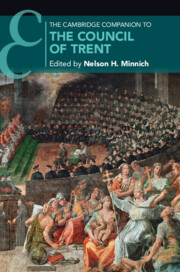Book contents
- The Cambridge Companion to the Council of Trent
- Frontispiece
- Cambridge Companions to Religion
- The Cambridge Companion to the Council of Trent
- Copyright page
- Contents
- Figures
- Contributors
- Acknowledgments
- Abbreviations
- 1 Introduction
- 2 The Organizational Structure of the Council of Trent
- 3 Schools of Theology at the Council of Trent
- 4 Scripture and Traditions at the Council of Trent
- 5 Original Sin and Justification
- 6 Sacraments in General, Baptism and Confirmation
- 7 The Sacrament of Penance at the Council
- 8 Presence and Sacrifice
- 9 Bishops
- 10 The Tridentine Proposal for the Formation of the Clergy
- 11 Pastoral Care
- 12 The Decree on Marriage
- 13 Reform of the Religious Orders
- 14 Sacred Art
- 15 Sacred Music
- 16 The Papacy and the Application of Conciliar Decrees
- Index
- Cambridge Companions to Religion (continued from page iii)
- References
9 - Bishops
Published online by Cambridge University Press: 02 October 2023
- The Cambridge Companion to the Council of Trent
- Frontispiece
- Cambridge Companions to Religion
- The Cambridge Companion to the Council of Trent
- Copyright page
- Contents
- Figures
- Contributors
- Acknowledgments
- Abbreviations
- 1 Introduction
- 2 The Organizational Structure of the Council of Trent
- 3 Schools of Theology at the Council of Trent
- 4 Scripture and Traditions at the Council of Trent
- 5 Original Sin and Justification
- 6 Sacraments in General, Baptism and Confirmation
- 7 The Sacrament of Penance at the Council
- 8 Presence and Sacrifice
- 9 Bishops
- 10 The Tridentine Proposal for the Formation of the Clergy
- 11 Pastoral Care
- 12 The Decree on Marriage
- 13 Reform of the Religious Orders
- 14 Sacred Art
- 15 Sacred Music
- 16 The Papacy and the Application of Conciliar Decrees
- Index
- Cambridge Companions to Religion (continued from page iii)
- References
Summary
The chapter reviews the models – ideal and actual – of the ‘good bishop’ put forward at the beginning of the sixteenth century, models which inspired those conciliar fathers most inclined to reform. It also looks at the debate pursued throughout the three phases of the council over the source of episcopal authority, focusing on the disputes about the theological basis of the obligation of residence. Finally, it will analyse what was new about the regulations regarding the clergy and the reforming decrees issued above all in the last sessions of the assembly, when the discord between the Curia party and the reformers threatened to wreck the council altogether. Without actually embracing the episcopalian position, the council did at least restate the importance of the care of souls, which was the responsibility of the pastors of the diocese, but failed to curtail the scope for curial intervention, the secular authorities’ nomination rights or the privileges enjoyed by the male religious orders.
- Type
- Chapter
- Information
- The Cambridge Companion to the Council of Trent , pp. 180 - 208Publisher: Cambridge University PressPrint publication year: 2023



